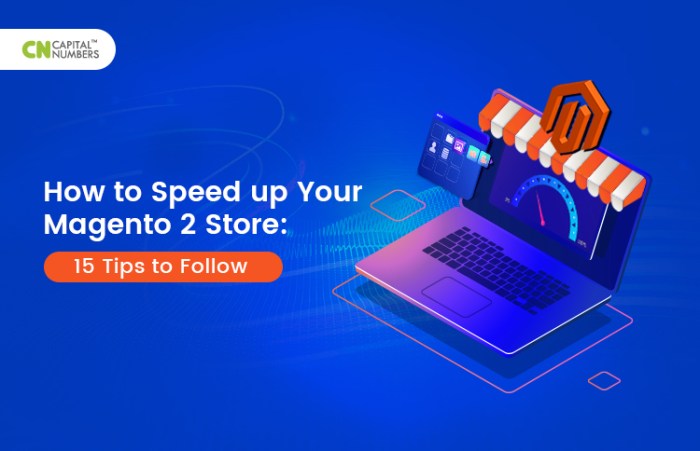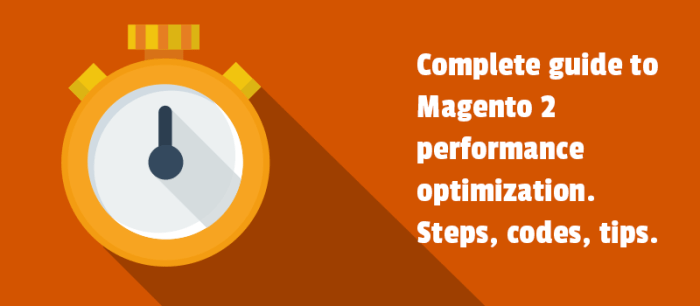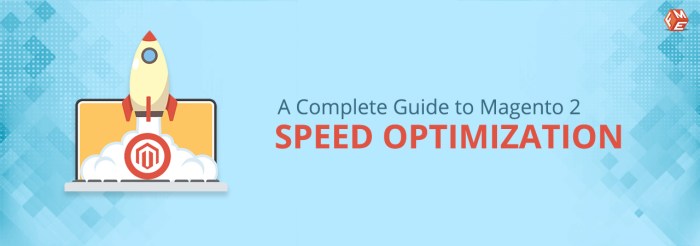Embark on a journey through Magento 2 Site Speed Optimization: A Complete Developer’s Guide, where we delve into the intricacies of enhancing website performance and user experience.
Explore the fundamental concepts and strategies Artikeld in this comprehensive guide to unleash the full potential of your Magento 2 site.
Introduction to Magento 2 Site Speed Optimization

Site speed optimization in Magento 2 refers to the process of enhancing the loading speed and performance of an e-commerce website built on the Magento 2 platform. This involves implementing various techniques and strategies to reduce page load times and improve overall user experience.Optimizing site speed is crucial for e-commerce websites due to its direct impact on user engagement, conversion rates, and search engine rankings.
Slow-loading websites can lead to higher bounce rates, lower customer satisfaction, and ultimately, loss of potential sales. In the competitive landscape of online retail, every second counts in retaining and converting visitors into customers.The impact of site speed on user experience is significant, as faster loading times lead to improved customer satisfaction, higher engagement, and increased likelihood of repeat visits.
Moreover, search engines like Google prioritize websites with fast loading speeds, considering it a key factor in determining search result rankings. A faster website not only enhances user experience but also boosts visibility and organic traffic through improved performance.
Understanding the Current State of Your Magento 2 Site

Analyzing the speed performance of your Magento 2 website is crucial to identify areas for improvement and enhance user experience. By understanding the current state of your site, you can take necessary steps to optimize its speed and performance.
Steps to Analyze Speed Performance
To analyze the speed performance of your Magento 2 website, follow these steps:
- Use tools like Google PageSpeed Insights or GTmetrix to conduct a speed test of your site.
- Check the loading time of your website and identify any bottlenecks or slow-loading elements.
- Analyze the server response time and optimize server settings if needed.
- Review the size of images, scripts, and CSS files to ensure they are optimized for faster loading.
Identifying Areas of Improvement
To identify areas of improvement for site speed, consider the following:
- Focus on optimizing images by compressing them without compromising quality.
- Minify CSS and JavaScript files to reduce load times.
- Enable browser caching to store static resources locally and speed up subsequent visits.
- Audit third-party extensions and scripts that may be impacting site performance.
Tools and Metrics for Measuring Site Speed Performance
Various tools and metrics can be used to measure site speed performance, including:
- Page load time: The time it takes for a webpage to fully load.
- Time to first byte (TTFB): The time it takes for the browser to receive the first byte of data from the server.
- Performance scores from tools like Lighthouse, which assess various aspects of site performance.
- Monitoring tools like New Relic or Datadog for real-time performance monitoring and alerts.
Implementing Best Practices for Magento 2 Site Speed Optimization

When it comes to optimizing the speed of your Magento 2 site, there are several key best practices you can implement to ensure improved performance and user experience. By following these guidelines, you can enhance the overall speed and efficiency of your e-commerce platform.
Leveraging Browser Caching
Browser caching is a crucial technique that helps reduce loading times for returning visitors to your site by storing static resources locally in their browser. This means that when a user revisits your site, their browser can quickly retrieve the cached resources instead of downloading them again from the server.
- Set the appropriate expiration headers for your static resources to instruct browsers on how long to cache them.
- Utilize tools like GTmetrix or Google PageSpeed Insights to identify opportunities for browser caching optimization.
- Consider implementing a content delivery network (CDN) to further enhance caching capabilities across different geographical locations.
Importance of Image Optimization
Images play a significant role in the overall appeal of your Magento 2 site, but they can also contribute to slower loading times if not optimized properly. By reducing the size and optimizing the format of your images, you can significantly improve site speed without compromising on visual quality.
- Compress images using tools like TinyPNG or ImageOptim to reduce file size without sacrificing image quality.
- Specify image dimensions in your HTML or CSS to prevent layout shifts and improve loading performance.
- Use lazy loading techniques to delay the loading of off-screen images until they are needed, reducing initial page load times.
Utilizing Caching Techniques in Magento 2
Caching plays a crucial role in improving the speed and performance of a Magento 2 website. By storing frequently accessed data, caching reduces the time needed to fetch information from the server, resulting in faster loading times for visitors. Let's dive into the different caching techniques available in Magento 2 and how they can enhance your site's speed.
Full-Page Caching in Magento 2
Full-page caching is a powerful technique in Magento 2 that can significantly improve site speed by storing entire pages as static files. When a user requests a page that has been cached, the server can deliver the pre-generated HTML content quickly without having to process PHP scripts or query the database again.
This leads to faster loading times and a smoother user experience.
- Full-page caching can be configured in Magento 2 by enabling the built-in Full Page Cache (FPC) feature. This can be done through the admin panel under the 'Stores' section.
- By default, Magento 2 uses Varnish Cache as the full-page caching mechanism. Varnish Cache is a powerful HTTP accelerator that stores cached pages in memory, allowing for lightning-fast retrieval and delivery to users.
- Configuring full-page caching involves setting cache lifetime, cache storage options, and cache types based on your site's requirements and traffic patterns.
Optimizing full-page caching can lead to a drastic improvement in site speed, reducing server load and enhancing the overall performance of your Magento 2 website.
Minifying CSS, JavaScript, and HTML in Magento 2
Minification is the process of removing unnecessary characters from code without affecting its functionality. This includes removing white spaces, comments, and other non-essential elements, resulting in smaller file sizes and faster loading times for your Magento 2 site.
Steps to Minify CSS, JavaScript, and HTML files in Magento 2
- 1. Minifying CSS:To minify CSS files in Magento 2, you can manually remove unnecessary spaces and comments from your CSS files. You can also use online tools like CSS Minifier or extensions like Minify CSS for Magento 2 to automate this process.
- 2. Minifying JavaScript:Similarly, you can manually minify JavaScript files by removing unnecessary characters. Tools like UglifyJS or extensions like Minify JS for Magento 2 can help automate this process.
- 3. Minifying HTML:To minify HTML files in Magento 2, you can remove extra spaces, comments, and line breaks. Tools like HTML Minifier or extensions like Minify HTML for Magento 2 can assist in this task.
Tools and Extensions for Minification Process
- 1. CSS Minifier:This tool helps compress CSS files by removing unnecessary characters, improving loading times.
- 2. Minify CSS for Magento 2 Extension:This extension automates the process of minifying CSS files in Magento 2, saving time and effort.
- 3. UglifyJS:A popular tool for minifying JavaScript files, reducing file sizes and speeding up your site.
- 4. Minify JS for Magento 2 Extension:This extension simplifies the minification of JavaScript files in Magento 2, enhancing site performance.
- 5. HTML Minifier:Used to minify HTML files by removing unnecessary characters, improving site speed.
- 6. Minify HTML for Magento 2 Extension:Automates the process of minifying HTML files, optimizing your Magento 2 site for speed.
Optimizing Server Configuration for Magento 2
Server configuration plays a crucial role in optimizing the speed and performance of your Magento 2 website. By fine-tuning various server settings, you can significantly improve the loading times and overall user experience. Let's delve into the key aspects of optimizing server configuration for Magento 2.
Optimizing PHP Version
- Upgrade to the latest stable version of PHP supported by Magento 2 for improved performance and security.
- Ensure that PHP opcode caching is enabled to reduce server response times and speed up page loading.
- Regularly monitor PHP error logs and performance metrics to identify and address any issues affecting site speed.
Optimizing MySQL Configurations
- Optimize MySQL settings such as query cache size, buffer pool size, and max connections to enhance database performance.
- Enable slow query logging to identify and optimize poorly performing database queries that may impact site speed.
- Consider using MySQL database indexes to improve query performance and reduce response times for database operations.
Choosing the Right Hosting Environment
- Opt for a hosting provider that offers dedicated resources, SSD storage, and scalable infrastructure to support Magento 2's resource-intensive requirements.
- Ensure that the hosting environment is optimized for Magento 2, with support for technologies like Varnish cache and Redis for enhanced caching and performance.
- Consider utilizing a content delivery network (CDN) to distribute site content geographically and reduce latency for users accessing your store from different locations.
Monitoring and Testing the Performance of Your Optimized Magento 2 Site
Monitoring and testing the performance of your optimized Magento 2 site is crucial to ensure that your website continues to deliver a fast and seamless user experience. By regularly monitoring and testing, you can identify any potential issues or bottlenecks that may arise and take corrective action promptly.
Importance of Ongoing Monitoring and Testing
Regular monitoring and testing of your Magento 2 site's performance help you to:
- Identify any performance degradation over time.
- Detect any issues that may impact user experience.
- Ensure the effectiveness of implemented optimization strategies.
- Stay ahead of any potential problems that may arise.
Tools and Techniques for Testing Performance
There are several tools and techniques available to test the performance of your Magento 2 website:
- Google PageSpeed Insights: Provides insights and recommendations for improving website speed.
- GTmetrix: Analyzes your site's speed performance and provides actionable recommendations.
- New Relic: Offers in-depth performance monitoring and analysis tools for Magento 2 sites.
- Load testing tools like JMeter or LoadNinja: Simulate high traffic scenarios to test site performance under load.
Interpreting Test Results and Making Further Optimizations
Once you have conducted performance tests, it is essential to interpret the results accurately and take necessary actions:
- Look for areas of improvement such as slow-loading scripts, large image files, or server response times.
- Address identified issues by optimizing code, images, or server configurations.
- Monitor the impact of optimizations by retesting and analyzing performance metrics.
- Continuously iterate and optimize based on test results to maintain optimal site speed.
Conclusive Thoughts
As we conclude our exploration of Magento 2 Site Speed Optimization: A Complete Developer’s Guide, remember that a well-optimized site not only boosts speed but also drives success in the competitive e-commerce landscape.
FAQ Section
How important is site speed optimization for Magento 2 websites?
Optimizing site speed is crucial for Magento 2 websites as it directly impacts user experience, search engine rankings, and ultimately, conversion rates.
What are the key best practices for optimizing site speed in Magento 2?
Some key best practices include leveraging browser caching, implementing image optimization, minifying CSS, JavaScript, and HTML files, and optimizing server configurations.
How can I monitor and test the performance of my Magento 2 site after optimization?
You can use various tools and techniques to monitor and test your site's performance, interpret the results, and make further optimizations if necessary.















